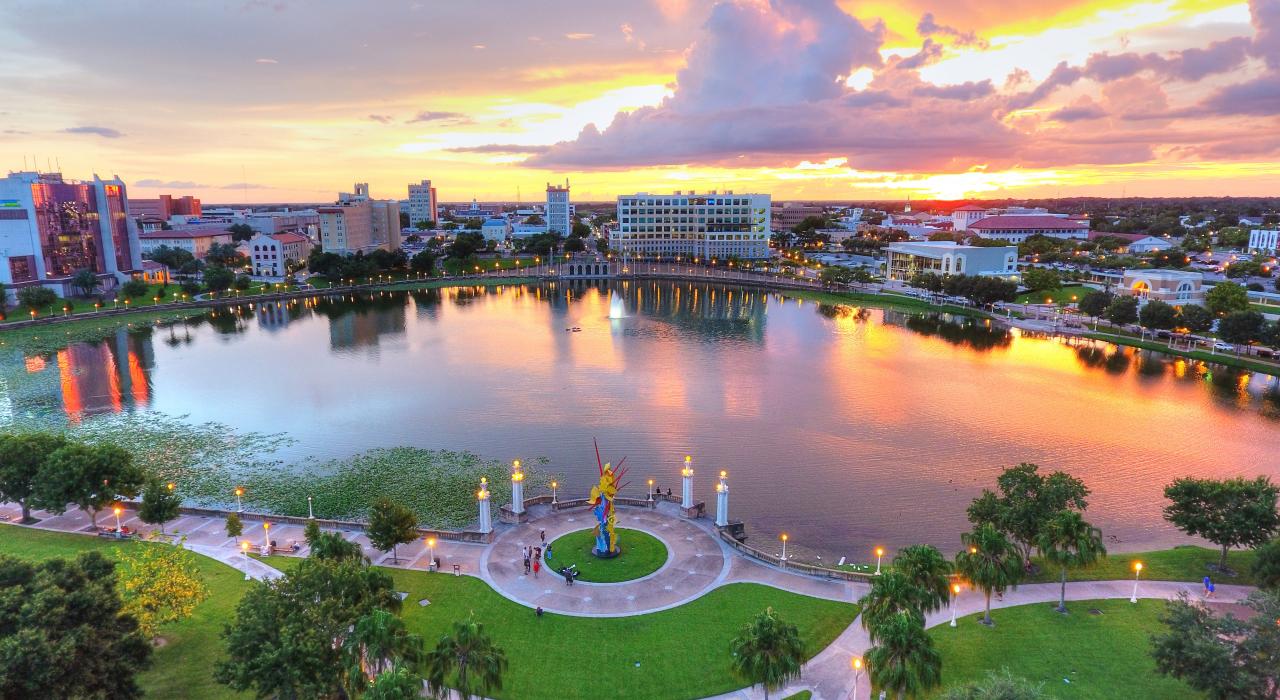The real estate market in Florida's counties is among the most promising in the United States for 2025. According to a recent survey by Realtor.com, regions such as Miami, Orlando and Jacksonville are standing out both in terms of sales volume and property appreciation. This data reinforces the growth trend in several areas of the state, putting Florida's counties in the spotlight among buyers, investors and real estate professionals.
Orlando - FL

Contents
HideWith the gradual stabilization of interest rates and a slight slowdown in the appreciation of real estate in some regions of the country, the US housing market is beginning to show consistent signs of recovery for 2025. According to data from Realtor.com, forecasts for next year indicate more significant growth in the southern and western regions of the country, where the cost of living is still more affordable than in the large metropolises of the east coast and California.
The survey showed that ten most promising markets for 2025 are all located in these two large geographical regions. Colorado Springs in Colorado took the lead, closely followed by South Floridawhere real estate market in Florida's countiesespecially in areas such as Miami and Orlando, is showing signs of strong expansion both in the number of sales and in the increase in prices.
Among the factors that explain this growth are the greater availability of real estate, the advancement of remote and hybrid work options, the flow of internal migration of residents from more expensive states and, in some cases, a faster recovery from the economic impacts of the pandemic. The South, in particular, has become a magnet for young families, investors and immigrants, which is directly boosting the real estate boom.
The Realtor.com platform has released its annual projection of the most promising real estate markets in the United States, and the 2025 report reveals a clear trend: all of the top 10 markets are concentrated in the south and west of the country. These markets were evaluated based on two main indicators: projected growth in the volume of sales of existing properties and an increase in the average price of properties.
See below for the complete ranking with the respective projections:
| Position | Metropolitan Region | Sales growth (1Q3) | Price growth (1TP3Q) |
|---|---|---|---|
| 1 | Colorado Springs, CO | 27,1% | 12,7% |
| 2 | Miami-Fort Lauderdale-Pompano Beach, FL | 24,0% | 9,0% |
| 3 | Virginia Beach-Norfolk-Newport News, VA-NC | 23,4% | 6,6% |
| 4 | El Paso, TX | 19,3% | 8,4% |
| 5 | Richmond, VA | 21,6% | 6,1% |
| 6 | Orlando-Kissimmee-Sanford, FL | 15,2% | 12,1% |
| 7 | McAllen-Edinburg-Mission, TX | 19,8% | 7,0% |
| 8 | Phoenix-Mesa-Chandler, AZ | 12,2% | 13,2% |
| 9 | Atlanta-Sandy Springs-Alpharetta, GA | 15,1% | 10,2% |
| 10 | Greensboro-High Point, NC | 17,3% | 7,7% |
A special highlight is the real estate market in Florida's countieswhich places two of its main regions, Miami and Orlando, among the six hottest in the country. This confirms Florida's continued attractiveness to both residents and investors, even against a backdrop of housing costs above the national average in areas such as Miami.
Realtor.com analysts explain that these markets have been driven by a combination of factors:
-
High demand for affordable housing in regions with a moderate cost of living;
-
Growing populationespecially in cities where there are more immigrants or families with children;
-
Property availability for sale and construction;
-
Adoption of the remote or hybrid modelThis allows for mobility and favors cities outside the major traditional centers.
This data reinforces the importance of keeping a close eye on the real estate market in Florida's counties, which continue to be protagonists in this new cycle of appreciation.
Among the 10 most promising real estate markets in the United States for 2025, two stand out as representing the most dynamic real estate market in Florida's counties: Miami-Fort Lauderdale-Pompano Beachin second place in the national ranking, and Orlando-Kissimmee-Sanfordin sixth place.
Miami-Fort Lauderdale-Pompano Beach (#2)
The Miami metropolitan area is expected to register a 24% growth in the volume of sales of existing properties compared to 2024, accompanied by a 9% increase in average property prices. Although Miami ranks among the least affordable markets, with housing costs compromising 42.1% of the average income, its international appeal, high concentration of foreign residents and large number of paid-off properties continue to attract buyers, especially investors and second-home seekers.
The expectation is that, even with average prices 10.5% higher than the pre-pandemic period (2017-2019), the region will once again approach historical transaction levels, indicating strong resilience and continued appreciation.
Orlando-Kissimmee-Sanford (#6)
The Orlando region, on the other hand, has even more impressive figures in terms of appreciation: while the volume of sales is expected to grow by 15.2% in 2025, average property prices could rise 12.1% in the yearThis is one of the highest percentage increases among the 10 markets listed. When compared to the pre-pandemic period, current prices in Orlando are 82.6% higher, which demonstrates a remarkable real estate boom in recent years.
In addition, the presence of young families, the migration of workers in search of better value for money and the growing offer of hybrid or remote working models have boosted demand. Orlando also stands out for its higher proportion of households with children, which tends to heat up the family housing segment.
These figures consolidate Florida's position as one of the most attractive states in the country for 2025and reinforce the strategic importance of monitoring the real estate market in Florida's counties, especially in areas such as Miami and Orlando, which continue to lead national growth indicators.
Sanford - FL
In addition to Miami and Orlando, the real estate market in Florida's counties has several other regions with promising performance for 2025. Data from the Realtor.com ranking puts five other Florida metropolitan areas among the top 25 in the country, all with significant growth in both the number of sales and the appreciation of real estate.
See the highlights:
| Position | Metropolitan Region | Sales growth (1Q3) | Price growth (1TP3Q) |
|---|---|---|---|
| 16 | Jacksonville | 13,5% | 9,8% |
| 17 | Cape Coral-Fort Myers | 13,2% | 9,6% |
| 21 | Lakeland-Winter Haven | 10,6% | 10,3% |
| 22 | Tampa-St. Petersburg-Clearwater | 9,1% | 11,8% |
| 33 | Deltona-Daytona Beach-Ormond Beach | 7,2% | 11,5% |
| 64 | North Port-Sarasota-Bradenton | 3,2% | 10,4% |
| 75 | Palm Bay-Melbourne-Titusville | 0,8% | 9,6% |
What do these figures reveal?
-
Jacksonville e Cape Coral maintain a balanced combination of appreciation and increase in sales, driven by population growth and urban expansion.
-
Lakeland-Winter Haven has been consolidating itself as a strategic option between Orlando and Tampa, offering properties with more affordable prices and good appreciation potential.
-
Tampa-St. Pete has one of the highest percentage increases in price among the markets analyzed, reflecting the growing demand for real estate in the west coast region.
-
Deltona-Daytona Beach e North Port-Sarasota remain attractive, especially for retirees and investors, thanks to the coastal lifestyle and stable climate.
Even the regions with the lowest percentage growth in sales, such as Palm Bay-Melbourne-TitusvilleIn addition, they project a solid increase in property values, which reinforces the resilience and appeal of the real estate market throughout the state.
These projections show that the real estate market in Florida's counties goes far beyond Miami and Orlando. The diversity of growing regions offers opportunities both for those looking for housing and for investors attentive to the potential for appreciation in the medium and long term.
Lakeland - FL

The above-average performance of the real estate market in Florida's counties in 2025 is no accident. Several structural factors have been driving the growth of the state's main regions, consolidating Florida as one of the most stable and dynamic real estate powers in the United States.
Accelerated economic recovery after the pandemic
While many states faced a prolonged downturn following the impacts of COVID-19, Florida has seen a faster recovery, thanks to a combination of less restrictive policies, tourism incentives and increased commercial activity. This early recovery has helped keep the construction sector active and attract new residents looking for stability and opportunities.
Immigration and high presence of foreign population
Florida continues to be one of the favorite destinations for immigrants from all over the world, especially Latin America, the Caribbean and Europe. Regions such as Miami, Orlando and Tampa concentrate well-established foreign communities, which generates a constant demand for housing, investment and short-term rental properties. This international character contributes to the liquidity and appreciation of real estate in various areas.
Remote work and the search for quality of life
With the consolidation of the hybrid and remote model, many families and self-employed professionals have migrated from expensive urban centers to more cost-effective regions. Florida offers exactly this balance: urban infrastructure, a favorable climate, good digital connectivity and leisure facilities, all at more affordable prices than large metropolises like New York or Los Angeles. This has increased interest in the real estate market in Florida's counties, especially in suburban areas and medium-sized cities.
Family profile and high number of owners
The Realtor.com study identified that the markets with the highest growth are those with high proportion of families with children and a high rate of fully paid-up properties. In Florida, many homeowners no longer have active financing, which strengthens the local economy and encourages reinvestment. In addition, cities like Orlando, Lakeland and Cape Coral are attracting young families looking for stability and opportunities to grow.
These factors help explain why the real estate market in Florida's counties remains so resilient, even in the face of macroeconomic uncertainties or changes in interest rates. The scenario for 2025 points to an even more favorable environment for those wishing to buy, sell or invest in the state.
Despite the positive performance and projected growth, the real estate market in Florida's counties also presents important challenges, especially with regard to accessibility and the cost of living in certain regions. The biggest example is Miami, which leads the appreciation indexes, but also tops the rankings for affordability.
Miami: rapid growth, but high costs
According to the Realtor.com report, Miami is the least affordable of the top 10 US markets for 2025. Housing costs consume, on average, 42.1% of family incomeThis is well above what is considered financially healthy. In addition, the cost of living in the region is 11.5% higher than the national average.
This imbalance between income and property prices can limit access to home ownership for local residents, pushing part of the demand towards renting or more affordable neighboring towns, which in turn puts pressure on these satellite markets.
Other Florida cities offer more balance
In contrast, regions such as Lakeland, Cape Coral and Palm Bay still maintain a more balanced relationship between average income and property valuesThis attracts first-time buyers as well as retirees and investors looking for properties with the potential to appreciate in value without the burden of a high cost of living.
This internal variation shows how much real estate market in Florida's counties is diverse: while some areas have already reached maturity and high prices, others still offer real opportunities for entry, with solid projections of appreciation.
Comparison with other regions in the ranking
While Florida stands out for its dynamism, other markets listed among the 10 most promising for 2025, such as McAllen, Texasfor example, offer greater accessibility. In McAllen, the cost of living is around 13% below the national averagemaking it the most economical on the list.
This contrast reinforces an essential point: the decision to buy or invest must take into account not only the potential for appreciation, but also the local context, average income, infrastructure, quality of life and feasibility of financing.
Therefore, although the real estate market in Florida's counties offers many opportunities, it is essential to make a careful analysis of each region. For some profiles, emerging cities like Tampa, Jacksonville and Lakeland can offer more return and stability than saturated markets like Miami.
With the projection of consistent growth and the diversity of markets on the rise, the real estate market in Florida's counties presents a range of opportunities for different buyer profiles, from families in search of home ownership to investors looking for profitability and liquidity.
Expectations of appreciation remain high
According to data from Realtor.com, Florida's main counties are expected to register average valuation between 9% and 12% throughout 2025, with Orlando and Tampa standing out. Even cities outside the national top 10, such as Deltona and Lakeland, project solid increases in real estate prices, indicating a broad and sustained growth trend.
Sales volumes are also expected to grow considerably. In regions such as Miami and Jacksonville, a jump of more than 20% in transactions is expected, which reinforces the appeal of liquidity in these markets, an essential factor for those seeking short or medium-term returns.
Options for those looking for affordability and liquidity
Not every investor needs to start in Miami or Orlando. Cities such as Cape Coral-Fort Myers, Palm Bay, North Port-Sarasota and Lakeland offer properties with more affordable average price and with significant potential for appreciation. These regions also tend to have lower vacancy rates in the rental market, which favors passive income strategies (such as long-term rentals or short-term rentals via platforms like Airbnb).
In addition, the combination of expanding urban infrastructure, attractive climate and proximity to major centers makes these "secondary" markets great bets for more strategic investors.
Considerations for foreigners wishing to invest in Florida
For international investors, especially Latin Americans and Europeans, the real estate market in Florida's counties remains one of the safest entry points for investment in the United States. This is due to:
-
Legal stability and protection of private property;
-
Easy financing for foreignerseven without resident status;
-
Consistent demand for vacation rentalsespecially in tourist areas such as Orlando and the west coast (Tampa, Sarasota, Fort Myers);
-
Presence of brokers and managers specialized in serving investors from abroad.
Although regions like Miami present challenges in terms of accessibility, the city's international prestige, strong appreciation and guaranteed liquidity make it a popular destination for foreign investors.
In short, the real estate market in Florida's counties stands out not only for its projected growth, but also for its variety of opportunities adaptable to different objectives, budgets and risk profiles. Whether for housing, investment or diversification of assets, 2025 promises to be a particularly favorable year for those who decide to bet on Florida.

Looking at the projected data for 2025, it's clear to see why the real estate market in Florida's counties continues to be one of the strongest and most resilient destinations in the United States. Whether it's the growth in sales, the appreciation of real estate or regional diversification, Florida offers a combination that is hard to find in other states: economic solidity, tourist appeal, a pleasant climate, job opportunities and a strong base of local and international buyers.
The state does not depend on a single city to maintain its relevance in the sector. Miami, Orlando, Tampa, Jacksonville, Lakeland and other regions continue to expand, each with its own public profile and type of investor. This regional dynamism is what makes Florida especially attractive: there is room for both those looking for high-end real estate and those looking for accessibility and growth potential.
What can we expect in the second half of 2025?
With interest rates expected to gradually stabilize and a broader economic recovery expected in the United States, the second half of 2025 could consolidate the growth seen so far. For attentive buyers, it will be a strategic period to close deals with good financing conditions, especially in markets that have not yet reached their peak.
In addition, the advance of internal migration and the continued interest of foreigners indicate that demand for residential and investment real estate is likely to remain strong. Therefore, being well advised will be essential to identify good opportunities, avoid legal pitfalls and ensure security at every stage of the purchase.
Talk to an expert and start planning your investment
If you are considering buying or investing in real estate in Florida, the team at The Florida Lounge is ready to help you. We specialize in serving Brazilians and foreigners who want to take advantage of the unique opportunities of the American market with peace of mind, strategy and security.
Sources used and recommended:
-
Realtor.com - Housing Forecast 2025: These 10 Markets Will Be the Hottest in America Next Year
Daytona Beach News-Journal - These Florida places made Realtor list of top 10 housing markets for 2025 -
U.S. Census Bureau - American Community Survey: Florida Demographic Trends
-
The Florida Lounge - Real Estate Advice for Brazilians in Florida
Thalita Felisardo
Born on VHS, a Super Nintendo warrior and a lifelong theme park addict. Broadcaster, publicist and Orlando explorer by passion! I used to be Mickey's neighbor and I've made over 100 visits to Disney and Universal parks 🎢. Today I've swapped the enchanted castles for the rocky mountains of Canada, but my heart is still divided between the Northern Lights and the Magic Kingdom fireworks.





